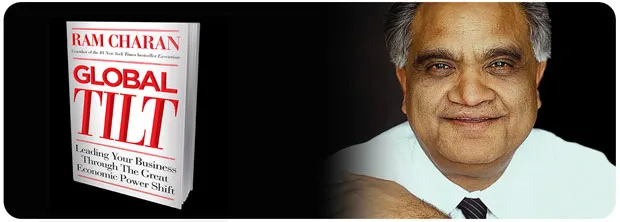[Book Review] Global Tilt: Leading Your Business Through the Great Economic Power Shift
by Ram Charan, 7 chapters; 322 pages, 2013 Random House
If you are up to speed on the term ‘flat world,’ this is the next term you need to understand: ‘tilted world,’ the shift of economic power — jobs, wealth, and market opportunities – from Northern countries to Southern countries (south of the 31st parallel). The West and Japan are “a physical and psychological ocean” away from countries such as China, India, Brazil, Mexico, Malaysia, Indonesia and Singapore.

According to research estimates, by 2015, the number of Asian middle class consumers will equal the number in Europe and North America; by 2030, India will account for about 23 per cent of global middle-class consumption, followed by China (18 per cent), US (7 per cent), and Germany and France (2 per cent each).
The world is becoming increasingly interconnected, complex and financially unstable, and driven by the forces of digitisation. In the last major economic shift, power tilted away from China, India and Japan towards Europe over centuries; this new shift is happening in mere decades, explains Ram Charan in his latest book. (See also my reviews of the books Reverse Innovation, China Fast Forward and India Inside).
Ram Charan is a world-renowned business advisor, author and speaker. His previous bestselling books include Execution, The Game Changer, Talent Masters, Leadership Pipeline, Know-How and Boards at Work. He has worked as a coach and consultant for GE, Bank of America, DuPont, Novartis, EMC, 3M, Verizon, Coca-Cola, 3M, Merck, Hindalco, Tyco, Aditya Birla Group, and Tata Group. He has an engineering degree from India and an MBA and doctorate from Harvard Business School.
Charan has been hailed by industry leaders as a gifted visionary, pragmatist, catalyst and even a ‘secret weapon.’ His latest book on global strategy is a good mix of case studies, literature review, personal anecdotes, business insights and actionable checklists.
Businesses in Southern countries have ready access to the capital and expertise they need to grow, and many of them are not yet known to companies in the North, thus creating disruption as well as opportunity. Momentum and spirit are on the side of the South: they are creating their own rules, with a blend of state capitalism, protectionism and even communism.
“Another characteristic of the new world economy will be invention of a type and scale never before seen,” says Charan. Innovation was dominated by MNCs and Western universities in the last century, but now innovators are emerging in Silicon Valley startups as well as entrepreneurs around the world. “Their ability to do so singly and collectively comes largely from the increasing real-time openness and democratisation of knowledge and availability of start-up funds in a digitised world,” Charan says.
Mobile phones and the Internet enable entrepreneurs to share information they could never before access. “Much of this innovation is at the local level for the local market, and some will find its way from one country to another. Online contests and crowdfunding help small-scale entrepreneurs get the money they need to develop their ideas,” says Charan.
Digitisation helps create new global industries from scratch in just a few years. Google, Vonage, Skype and Apple have disrupted the telecom industry; Amazon is challenging retailers such as Best Buy and Walmart. The Internet of Things and Big Data can also improve supply chains and operating margins.
“The most dramatic change of all may be the power of digital technology to create structural changes in the composition of national economies,” predicts Charan, with the rise of mobile penetration as compared to landlines in Africa and India.
In addition to the BRIC nations (Brazil, Russia, India, China), Charan also advises keeping an eye on the CIVETS nations (Colombia, Indonesia, Vietnam, Egypt, Turkey, South Africa). China has not only created successful private companies like Haier and Huawei but state-owned enterprises in strategic industries, with a much longer-term focus than Wall Street companies. Companies and talent from Southern countries are expanding across their regions as well, such as Marico (from India to the Middle East) and Airtel (from India to Africa); mining companies from Indonesia, Brazil and South Africa are luring away Indian engineering graduates.
Charan provides detailed profiles of successful Southern large-scale entrepreneurs: GMR Group, Hindalco, Airtel, Ambev and Haier. They have aggressively expanded even into domains where they have no prior familiarity, recruited the best local and Western talent, focused on tight margins as well as long term strategy, innovated on business models, and built strong brands.
In addition to ‘tilted world,’ other important terms explained by Charan include “outside-in” and “future-back” thinking – looking at your business through the lens of another leader sitting elsewhere, and looking back from time horizons 20 years into the future.
Charan also profiles Northern companies who have successfully made the global tilt: Dow Chemicals (moving from commodity to specialty chemicals), Allied Signal (moving from auto parts to aerospace), Thomson (moving from print newspapers to digital business information), P&G (moving one headquarters to Singapore), GE (forming an avionics joint venture in China; selling its plastics division to Saudi Arabia), Borealis (forming a joint venture in Abu Dhabi), and 3M (centres of excellence in emerging economies).
The decades ahead will witness increasing competition for resources and jobs, trade imbalances, and talent shortages; business leaders and entrepreneurs should factor these in now in their long term plans. “Information is readily available. Time for reflection is what’s in short supply,” Charan observes. Business leaders should be on the alert for pivotal events and be able to see bends in the road ahead.
To do so, leaders need to ‘use buckets rather than spoons’ and ‘take a flight instead of driving a car’ – in other words, expand their thinking and strategic horizon. This also calls for ‘multicontextual thinking’ -- blending multiple local perspectives via structural and social changes in organisational information flow and decision making power.
Soft skills matter a lot in dealing with businesses and customers in different countries; social networks of ‘global integrator’ leaders need to be culturally diverse and experientially deep. Formal and informal discussions with business leaders from various cultures are needed so that people connect with issues and with each other socially as well as intellectually. “In many cases, you may have to be less efficient to be more effective,” Charan accurately describes.
The concluding chapter provides a checklist of how business leaders should create tangible vision, develop strong talent pools, direct budgets towards growth, adjust compensation, let knowledge flow, and make the right decisions.
“The pace and timing of the global tilt may be uncertain, but the direction is clear,” concludes Charan. Use imagination to see opportunities before they fully form, and the courage to act in the face of uncertainly, he advises.
It would be apt to end the review with some of the good quotes in the book.
“Control your destiny or someone else will.” – Jack Welch
“Attitude is a little thing that can make a big difference.” – Winston Churchill
“If you’re caught between speed and perfection, always choose speed and perfection will follow.” – Sunil Mittal
“I skate to where the puck is going to be, not where it has been.” – Wayne Gretzky
[Follow YourStory's research director Madanmohan Rao on Twitter at http://twitter.com/MadanRao]






![[Book Review] Global Tilt: Leading Your Business Through the Great Economic Power Shift](https://images.yourstory.com/cs/wordpress/2013/05/tilt.jpg?mode=crop&crop=faces&ar=2:1?width=3840&q=75)




